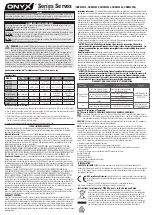
28
Rockwell Automation Publication 750-TG101A-EN-P - June 2022
Chapter 2 Preventative and Predictive Maintenance
maintenance of these devices is needed, it is specified in their individual
instructions. If in doubt, consult your nearest Rockwell Automation sales
office for information.
Contacts
- Check contacts for excessive wear and dirt accumulation. To
remove dirt, clean contacts with a soft cloth. Discoloration and slight pitting
does not harm contacts. Do not file contacts - this action shortens the life of
the contact. Do not use contact spray cleaners because residue on magnet pole
faces or in operating mechanisms can cause sticking, and on contacts can
interfere with electrical continuity. Replace contacts only after the silver has
become badly worn. Always replace contacts in complete sets to avoid
misalignment and uneven contact pressure.
Terminals
- Loose connections in power circuits can cause overheating that
can lead to equipment malfunction or failure. Loose connections in control
circuits can cause control malfunctions. Loose bond or ground connections
can increase hazards of electrical shock and contribute to electromagnetic
interference (EMI). Check the tightness of all terminals and bus bar
connections and torque any loose connections properly. Infrared technology
can be used to check for loose connections (high resistance/hot spot) during
periodic maintenance. Replace any parts or wiring that is damaged by
overheating, and any broken wires or bond straps.
Coils
- If a coil is overheated (contains cracked, melted, or burned insulation),
it must be replaced. To correct possible future coil damage or failure, check for
and correct any overvoltage or undervoltage conditions. Be sure to clean any
residues of melted coil insulation from other parts of the device or replace such
parts.
Pilot Lights
- Replace any burned out lamps or damaged lenses.
Photoelectric Switches
- The lenses of photoelectric switches require periodic
cleaning with a soft dry cloth. Reflective devices that are used with
photoelectric switches also require periodic cleaning. Do not use solvents or
detergents on the lenses or reflectors. Replace any damaged lenses and
reflectors.
Solid-state Devices
High-Voltage Testing
- Do not perform high-voltage insulation resistance (IR)
and dielectric withstanding voltage (DWV) tests to check solid-state control
equipment. When measuring IR or DWV of electrical equipment such as
transformers or motors, a solid-state device that is used for control or
monitoring must be disconnected before performing the test. Even though no
damage is readily apparent after an IR or DWV test, the solid-state devices are
degraded and repeated application of high voltage can lead to failure.
ATTENTION:
Use of other than factory-recommended test equipment for solid-
state controls can result in damage to the control or test equipment or
unintended actuation of the controlled equipment. See paragraph titled HIGH
VOLTAGE TESTING.
Solid-state devices require little more than a periodic visual inspection.
Discolored, charred, or burned components can indicate the need to replace the
component or circuit board. Make necessary replacements only at the circuit
board or plug-in component level. Inspect printed circuit boards to determine
whether they are properly seated in the edge board connectors. Board locking
tabs must also be in place. Solid-state devices must also be protected from
contamination, and temperature control provisions must be maintained - refer to
paragraphs titled CONTAMINATION and COOLING DEVICES. Do not use solvents on
printed circuit boards.
















































